NCERT Solutions for Class 12 Accountancy Chapter 2 Accounting for Partnership : Basic Concepts
TEST YOUR UNDERSTANDING – I
1. Mohan and Shyam are partners in a firm. State whether the claim is valid if the
partnership agreement is silent in the following matters:
(i) Mohan is an active partner. He wants a salary of Rs. 10,000 per year;
Answer Invalid
I In the absence of partnership agreement, no interest on capital, interest on drawings, salary, commission is to be allowed to partners.
(ii) Shyam had advanced a loan to the firm. He claims interest @ 10% per annum;
Answer Invalid
Interest on partners loan to be allowed @ 6% pa,
(iii) Mohan has contributed Rs. 20,000 and Shyam Rs. 50,000 as capital. Mohan wants equal share in profits.
Answer Valid
Profit and losses are to be shared equally.
(iv) Shyam wants interest on capital to be credited @ 6% per annum.
Answer Invalid
No interest on capital is to be allowed to partners.
2. State whether the following statements are true or false:
(i) Valid partnership can be formulated even without a written agreement between the partners;
Answer True
(ii) Each partner carrying on the business is the principal as well as the agent for all the other partners;
Answer True
(iii) Maximum number of partners in a banking firm can be 20;
Answer True
(iv) Methods of settlement of dispute among the partners can’t be part of the partnership deed;
Answer False
(v) If the deed is silent, interest at the rate of 6% p.a. would be charged on the drawings made by the partner;
Answer False
(vi) Interest on partner’s loan is to be given @ 12% p.a. if the deed is silent about the rate.
Answer False
DO IT YOURSELF
Q.1. Soumya and Bimal are partners in a firm Sharing profits and losses in the ratio of 3:2. The balance in their capital and current accounts as on April 01, 2006 were as under:

The partnership deed provides that Soumya is to be paid salary @ Rs, 500 per month where as Bimal is to get a commission of Rs. 40,000 for the year. Interest on capital is to be credited at 6% p.a. The drawings of Soumya and Bimal for the year
were Rs. 30,000 and Rs. 10,000 respectively. The net profit of the firm before making these adjustment was Rs, 2,49,000. Interest on Soumya’s drawings was Rs. 750 and
Bimal’s drawings, Rs. 250. Prepare Profit and Loss Appropriation Account and Partner’s Capital and Current Accounts.



2. Soniya, Charu and Smita started a partnership firm on April 1, 2006. They contributed Rs, 5,00,000, Rs. 4,00,000 and Rs. 3,00,000 respectively as their capitals and decided to share profits and losses in the ratio of 3:2:1.The partnership provides that Soniya is to be paid a salary of Rs. 10,000 per
month and Charu a commission of Rs. 50,000. It also provides that interest on capital be allowed @6% p.a. The drawings for the year were Soniya Rs. 60,000, Charu Rs. 40,000 and Smita Rs. 20,000. Interest on drawings was charged as Rs. 2,700 on Soniya’s drawings, Rs. 1,800 on Charu’s drawings and Rs. 900 on Smita’s drawings. The net amount of profit as per Profit and Loss Account for the year 2006-07 was Rs. 3,56,600.
(i) Record necessary journal entries.
(ii) Prepare profit and loss appropriation account
(iii) Show capital accounts of the partners.




TEST YOUR UNDERSTANDING – II
1. Raju and Jai commenced business in partnership on April 1, 2006. No partnership agreement was made whether oral or written. They contributed Rs. 4,00,000 and
Rs. 1,00,000 respectively as capitals. In addtion, Raju advanced Rs. 2,00,000 as loan to the firm on October 1, 2006. Raju met with an accident on July 1, 2006 and could not attend the business up to september 30, 2006. The profit for the year ended March 31, 2007 amounted to Rs, 50,600. Disputes have arisen between them on sharing the profits of the firm.
Raju Claims:
(i) He should be given interest at 10% p.a. on capital and so also on loan.
(ii) Profit should he distributed in the proportion of capitals.
Jai Claims:
(i) Net profit should be shared equally.
(ii) He should be allowed remuneration of Rs, 1,000 p.a. during the period of
Raju’s illness.
(iii) Interest on capital and loan should be given @ 6% p.a.
State the correct position on each issue as per the provisions of the partnership Act. 1932.
Answer Raju’s Claims
(i) He cannot claim interest on capital and he is entitled only for 6A interest on loan.
(ii) In absence ot any agreement profits are distributed equally
Jai’s Claims
(i) It will be accepted.
(ii) He is not entitled for any remuneration.
(iii) No interest on capital is allowed whereas 6% interest for loan should be given.
2. Reena and Raman are partners with capitals of Rs. 3,00,000 and Rs. 1,00,000 respectively. The profit (as per Profit and Loss Account) for the year ended March
31, 2007 was Rs. 1,20,000. Interest on capital is to be allowed at 6% p.a. Raman was entitled to a salary of Rs. 30,000 p.a. The drawings of partners were Rs. 30,000 and 20,000. The interest on drawings to be charged to Reena was Rs. 1,000 and to Raman, Rs. 500.
Assuming that Reena and Raman are equal partners. State their share of profit after necessary appropriations.

TEST YOUR UNDERSTANDING -III
1.Rani and Suman are in partnership with capitals of Rs, 80,000 and Rs. 60,000, respectively. During the year 2006-2007, Rani withdrew Rs. 10,000 from her capital and Suman Rs. 15,000. Profits before charging interest on capital was Rs. 50,000. Ravi and Suman shared profits in the ratio of 3:2. Calculate the amounts of interest on their capitals @ 12% p.a. for the year ended March 31, 2007.


2. Priya and Kajal are partners in a firm, sharing profits and losses in the ratio of 5:3. The balance in their fixed capital accounts, on April 1, 2006 were: Priya,
Rs. 6,00,000 and Kajal, Rs. 8,00,000. The profit of the firm for the year ended March 31, 2007 is Rs, 1,26,000. Calculate their shares of profits: (a) when there is no agreement in respect of interest on capital, and (b) when there is an agreement that the interest on capital will be allowed @ 12% p.a.


DO IT YOURSELF
1. Govind is a partner in a firm. He withdrew the following amounts during the year 2006-07:
DATE (Rs.)
April 30, 2006 6,000
June 30, 2006 4,000
Sept. 30, 2006 8,000
Dec. 31, 2006 3,000
Jan. 31, 2007 5,000
he interest on drawings is to be charged @ 6% p.a. The books are closed on March 31, every year.

2. Ram and Syam are partners sharing profits/losses equally. Ram withdrew Rs. 1,000 p.m. regularly on the first day of every month during the year 2006-07 for personal expenses. If interest on drawings is charged @ 5% p.a. Calculate interest on the drawings of Ram.

3. Verma and Kaul are partners in a firm. The partnership agreement provides that interest on drawings should be charged @ 6% p.a. Verma withdraws Rs. 2,000 per month starting from April 01, 2006 to March 31, 2007. Kaul withdrew Rs, 3,000 per quarter, starting from April 01, 2006. Calculate interest on partner’s drawings.

DO IT YOURSELF
Q.1.Gupta and Sarin are partners in a firm sharing profits in the ratio of 3:2. Their fixed capitals are: Gupta 2,00,000, and Sarin 3,00,000. After the accounts for the year are prepared it is discovered that interest on capital @10% p.a. as provided in the partnership agreement, has not been credited in the capital accounts of partners before distribution of profits. Record adjustment entry to rectify the error.


2. Krishna, Sandeep and Karim are partners sharing profits in the ratio of 3:2:1. Their fixed capitals are: Krishan Rs. 1,20,000, Sandeep 90,000 and Karim 60,000.
For the year 2006-07, interest was credited to them @ 6% p.a. instead of 5% p.a. Record adjustment entry.

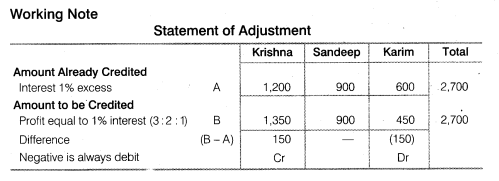
3. Leela, Meera and Neha are partners and have omitted interest on capital @9% p.a. for three years ended March 31, 2007. Their fixed capitals on which interest was to be allowed throughout were: Leela Rs. 80,000, Meera Rs. 60,000 and Neha Rs. 1,00,000. Their profit sharing ratio during the last three years were:


SHORT ANSWER TYPE QUESTIONS
Question 1. Define Partnership Deed.
Answer A partnership deed is a agreement among the partners which contains ai! the terms of the Partnership. It generally contains the details about all the aspects affecting the relationship between the partners including the objective of business, contribution of capita! by each partner, -atio in which the profits and the losses will be shared by the partners and entitlement of partners to interest on capital, interest on loan etc.
Question 2. Why it is considered desirable to make the partnership agreement in writing?
Answer As .per Partnership Act 1932 it is not necessary that a partnership agreement must be in writing but still it is always suggested that it should be in written form Because today there are very good relationship among the partners but n future if there may be any dispute regarding any issue, a written partnership agreement will help in avoiding disputes and misunderstandings among the partners.
Question 3. List the items which may be debited or credited in capital accounts of the partners when
(i) Capitals are fixed
(ii) Capitals are fluctuating
Answer (i)When capitals are fixed, the following items will be debited or^ credited in partners capital account


Question 4. Why is Profit and Loss Adjustment Account prepared? Explain.
Answer Profit and loss adjustment account is prepared to record those transaction or omissions and errors which were left while preparing the final accounts and they are found after the final accounts have been prepared and the profits distributed among the partners. The omission may be in respect of interest on capital, interest on drawings, interest on partners’ loan, partner’s salary, partner’s commission or outstanding expenses.
There may also be some changes in the provisions of partnership deed or system of accountings having impact with retrospective effect. All these acts of omission and commission need adjustments for correction of their impact. These omission errors and corrections can be recorded in partners’ capital account directly but still it seems convenient to prepare the profit and loss adjustment account.
Question 5. Give two circumstances under which the fixed capitals of partners may change.
Answer Under the fixed capital method the capital of partners may change in the following two circumstances
(i) First, when fresh capital is introduced by the partner with the consent of other partners.
(ii) Second, when a part of capital is withdrawn by the partner with the consent of other partners.
Question 6. If a fixed amount is withdrawn on the first day of every quarter, for what period the interest on total amount withdrawn will be calculated?
Answer When fixed amount of money is withdrawn quarterly, it can be withdrawn either at the beginning or at the end of each quarter, if the amount is withdrawn at the end of each quarter, the interest is calculated on the total money withdrawn during the period of seven and half months .
Question 7. In the absence of partnership deed, specify the rules relating to the following
(i) Sharing of profits and losses (ii) Interest on partner’s capital
(iii) Interest on partner’s drawings (iv) Interest on partner’s loan
(v) Salary to a partner
Answer :(i)Sharing of Profit and Losses
In the absence of partnership deed profit sharing ratio among the pad maw will be equal.
(ii) Interest on Partner’s Capital
In the absence of paonemnio oeeu interest on partners capital will not be given.
(iii) Interest on Partner’s Drawings
In the absence of partnership deed no interest will be charged on partners drawings .
(iv) Interest on Partners Loan
In the absence of partnership deed if partner gives any loan to the firm he/she will be entitled to get fixed percentage of interest @6% of annum.
(v) Salary of Partner
In the absence of the patnership deed a partner will be entitled for getting any salary for his work even if the other are non working.
Long Answer Type Questions
Question 1. What is partnership? What are its chief characteristics? Explain.
Answer According to the Section 4 of the Partnership Act, 1932
Partnership is an agreement between two or more persons who have agreed to share profits or losses of a business that will be carried by all or any one of them acting for all.
Person who joined their hands to set up the business are called ‘partners individually and ‘firm’ collectively and the name under which they carry out their business is termed as ‘firm name’.
The following are the important characteristics of partnership
(i) Two or More Persons
In order to form partnership, there should be at least two person coming together for a common goal In other words, the minimum number of partners in a firm can be two. There is however, a limit on their maximum number, if a firm is engaged in the banking business, it can have a maximum of ten partners while in case of any other business, the maximum number of partners can be twenty.
(ii) Partnership Deed
A partnership deed is an agreement among the partners which contains all the terms of the partnership. It generally contains the details about all the aspects affecting the relationship between the partners including the objective of business, contribution of capital by each partner, ratio in which the profits and the losses will be shared by the partners and entitlement of partners to interest on capital, interest on loan, etc.
(iii) Business
One of the important characteristics of a partnership is that it is formed to carry out a legal business. Partnership in case of illegal business is not valid.
(iv) Sharing of Profit
In case of a partnership the partners are suppose to share profit or loss on an agreed ratio or as per the provisions of the Partnership Act, 1932, as per which they will share profit equally.
(v) Liability
In the case of a partnership liability of partners are unlimited. If there is any obligation against the third party the partner will have to pay it out of his personal property.
Question 2. Discuss the main provisions of the Indian Partnership Act, 1932 that are relevant to partnership accounts if there is no partnership deed.
Answer It is always suggested that there must be a partnership deed among the partners before getting into any partnership venture. But sometimes a partnership is started without signing any such document. In this case the rules of partnership will be applicable as per the provisions of the Indian Partnership Act, 1932. The following are the provisions that are relevant to the partnership accounts in absence of partnership deed.
(i) Profit Sharing Ratio When a partnership deed is not made or even if it is made and silent on sharing of profit or losses among the partners of a firm, then according to the Partnership Act 1932, profits and losses are to be shared equally among all the partner of the firm.
(ii) Interest on Capital When there is absence of partnership deed or the partnership deed is silent on the issue related to interest on partner’s capital, then according to the Partnership Act 1932, no interest on partners’ capital will be provided. However, if they mutually agree on this issue than they are free to give interest on capital out of the profit of the firm.
(iii)Interest on Drawings there is no partnership Peed the issue ‘elated h die interest on drawing will be handled according to the provisions Partnership Act. 1932 According sc which no Interest on drawing will be charge loan the orders on withdraw in the form of drawings.
(iv) Interest on Partner’s Loan When there is no partnership deed among the partners or the partnership deed is silent on interest on partner’s loan then according to the Partnership Act, 1932. the partners are entitled for 6% pa interest on the loan forwarded by them to the firm
(v) Salary to Partner When partnership deed is not there or it is silent on the issue related to salary to a partner, then as per the rules of the partnership Act. 1932. no partner will be entitled to any salary.
Question 3. Explain why it is considered better to make a partnership agreement in writing.
Answer As per Partnership Act. 1932, it is not necessary that a partnership agreement must be in writing but still it is always suggested that it should be in written form. Because today there are very good relationship among the partners but in future there may be any dispute regarding any Issue a written partnership agreement will help in avoiding dusputes and misunderstandings among the partners.
In this way a written partnership deed is more desirable than the ora agreements. A written partnership agreement ensures the smooth functioning of the business of the partnership firm It aiso helps in settling the disputes among the partners. Moreover a duly signed and registered partnership deed can be used as evidence in the court of law. Therefore, it s desirable to form partnership deed in writing because of the moots associated with written documents over its oral counterparts.
Question 4. Illustrate how interest on drawings will be calculated under various situations.
Answer When a partner withdraws any amount, either in cash or in any other form, from the firm for his/her personal use, then it is termed as drawings. The interest charged by the firm on the amount of drawings is termed as interest on drawings. The method of calculating interest on drawings depends on the information available for time and frequency of the drawings made by the partner. The following different situations of drawings made illustrate the calculation of interest charged on drawings.
Situation I When ail the information regarding amount, date and rate of interest on drawings is given
When a partner withdrew Rs 10,000 on July 01 and interest on drawings is charged at 12% pa and the firm closed its books on December 31 every year then interest on drawings amount to Rs 600.

Situation(II) When information regarding amount, rate of interest on drawings is given
Case I Sometimes amount and rate of interest on drawings (per annum) is given but date is not mentioned
in this case when the details regarding the amount of drawings and rate of interest on drawings (pa) is given but the date of drawings is not given then interest will be charged on average basis and the period of drawings will be taken as 6 months
![]()
Case II Sometimes the amount and rate of is interest on drawings is given but the date and per anum rate of interest is not mentioned.
In this case when the date and the rate of interest aim given but per annum is not specified, then annual interest is charged.
e.g., If a partner withdrewRs 10 000 and interest rate is 12%, then the interest on drawings amounts to Rs.12,000.

Situation III When a fixed amount is withdrawn at regular interval
Case I Sometimes a fixed amount is withdrawn at the beginning of each month and the rate of interest is given then the interest is calculated for 6 5 months.
e.g.. If a partner withdraws Rs1,000 in the beginning of every month and the rate of interest is 12% pa, then the interest on drawings amount to RS 780.

Case II Sometimes a fixed amount is withdrawn at the end of each month and the rate of interest is given then the interest is calculated for 5.5 months.
e.g.. if a partner withdraws Rs 1.000 at the end of each month arid rate of interest is 12% pa then the interest on drawings amount to Rs 660.

Case III Sometimes a fixed amount is withdrawn at the mid of each month and the rate of interest is given then the interest is calculated for 6 months.
e g. if a partner.withdraws Rs.1,000 on 15th of every month and the rate of in’crest is 12% pa then the interest on drawings amount to Rs 720.

Case IV If a fixed amount is withdrawn in the beginning of every quarter then the interest is calculated for 7.5 months.
e.g.. If a partner withdraws Rs.5,000 in the beginning of every quarter and the rate of interest is 12% pa then the interest on drawings amount to Rs 1,800.

Case V If a fixed amount is withdrawn at the end of every quarter, then the interest is calculated for 4.5 months.
e.g., If a partner withdraws Rs. 5,000 at the end of every quarter and the rate of interest is 12% pa then the interest on drawings amounts to Rs. 900

Situation IV When different amount is at different intervals
When different amount is withdrawn by a partner at different dates then the interest is calculated by product method. The period of drawings is calculated from the date of withdrawal to the last date of the accounting year,
e.g., A partner withdraws?6,000 on March 01, Rs.4,000 on June 01, Rs.5,000 on Aug 30 and Rs.2,000 on Nov 30 and the rate of interest on drawings is 12% pa. The firm closes its book on December 31.

Question 5. How will you deal with a change in profit sharing ratio among existing partners? Take imaginary figures to illustrate your answer.
Answer Change in the profit sharing ratio occurs only in case of the admission, retirement or death of a partner or sometimes due to the general agreement among the partners in which they may decide to change the profit sharing ratio. There may be number of issues that should be considered during the change in the profit sharing ratio such as goodwill, reserves and accumulated profits, profit or loss on the revaluation of assets and liabilities and adjustment of capital, etc.
As far as the issue related to general reserve is concerned it is basically the accumulated profits (if any) and profit (or loss) on revaluation of assets and liabilities and should be distributed in the partner’s capital account in partners old profit sharing ratio.
Sometimes the existing partners may decide to change the profit sharing ratio then some partners gain at the cost of other partners. In other words one partner gain and other one sacrifice equal to the gain. In that case the former should compensate the latter. Therefore, the gaining partner’s capital account’s are debited to the extent of their gain and sacrificing partner’s capital accounts are credited to the extent of their sacrifice .The following journal entry is passed

Example Ram. Mohan and Shyam are partners in a firm sharing profit and loss in 3 2 :1 ratio. They decide to share profit and loss equally in future. On dm: date, the books of the firm showsRs.2.40.000 as general reserve, profit on ^evaluation of Plant and Machinery Rs.60.000. The following adjustment entry is passed through the capital accounts without affecting the books of accounts.

Hence, in the above example. Shyam gains at the cost of Ram. so the Ram needs to be compensated by Shyam with the amount of Rs.50.000. The following adjustment entry is passed.

Numerical Type Problems
1. Triphati and Chauhan are partners in a firm sharing profits and losses in the ratio of 3:2. Their capitals were Rs.60,000 and Rs.40,000 as on January 01, 2005. During the year they earned a profit of Rs. 30,000. According to the partnership deed both the partners are entitled to Rs. 1,000 per month as Salary and 5% interest on their capital. They are also to be charged an interest of 5% on their drawings, irrespective of the period, which is Rs. 12,000 for Tripathi, Rs. 8,000 for Chauhan. Prepare Partner’s Accounts when, capitals are fixed.
Answer In case, Interest on capital ,partners salary and interest on drawings is charged against profit.



2.Anubha and Kajal are partners of a firm sharing profits and losses in the ratio of 2:1. Their capital, were Rs.90,000 and Rs.60,000. The profit during the year were Rs. 45,000. According to partnership deed, both partners are allowed salary, Rs. 700 per month to Anubha and Rs. 500 per month to Kajal. Interest allowed on capital @ 5%p.a. The drawings at the end of the period were Rs. 8,500 for Anubha and Rs. 6,500 for Kajal. Interest is to be charged @ 5% p.a. on drawings. Prepare partners capital accounts, assuming that the capital account are fluctuating.
Answer. Assuming that partners salary,interest on capital and interest on drawinghave already been adjusted in profit and loss account.


3.Harshad and Dhiman are in partnership since April 01, 2006. No Partnership agreement was made. They contributed Rs. 4,00,000 and 1,00,000 respectively as capital. In addition, Harshad advanced an amount of Rs. 1,00,000 to the firm, on October 01, 2006. Due to long illness, Harshad could not participate in business activities from August 1, to September 30, 2006. The profits for the year ended March 31, 2006 amounted to Rs. 1,80,000. Dispute has arisen between Harshad and Dhiman.
Harshad Claims:
(i) he should be given interest @ 10% per annum on capital and loan;
(ii) Profit should be distributed in proportion of capital;
Dhiman Claims:
(i) Profits should be distributed equally;
(ii) He should be allowed Rs. 2,000 p.m. as remuneration for the period he managed the business, in the absence of Harshad;
(iii) Interest on Capital and loan should be allowed @ 6% p.a. You are required to settle the dispute between Harshad and Dhiman. Also prepare Profit and Loss Appropriation Account.
Answer Decisions according to partnership Act,1932, if there is no agreement .
Decission on Harshads Claim
(i) Interest on partners capital will not be allowed to partners
(ii) Profits shall be distributed equally among all the partners
Decission on Dhimans Claim
(i) Profits should be distributed equally among all the partners, fii) No salary shall be allowed to any partner if there is no agreement regarding remuneration.
(iii) Interest shall be allowed on partner’s Loan @ 6% pa whereas no interest is allowed on capital.

4.Aakriti and Bindu entered into partnership for making garment on April 01, 2006 without any Partnership agreement. They introduced Capitals of Rs. 5,00,000 and Rs. 3,00,000 respectively on October 01, 2006. Aakriti Advanced. Rs, 20,000 by way of loan to the firm without any agreement as to interest. Profit and Loss account for the year ended March 2007 showed profit of Rs, 43,000. Partners could not agree upon the question of interest and the basis of division of profit.
You are required to divide the profits between them giving reason for your solution.
Answer In the absence of any agreement between partners
(i) Interest on partners loan is allowed @ 6% pa.
(ii) Interest on capital shall not be allowed.
(iii) Profits are to be distributed equally.

5.Rakhi and Shikha are partners in a firm, with capitals of Rs. 2,00,000 and Rs, 3,00,000 respectively. The profit of the firm, for the year ended 2006-07 is Rs. 23,200. As per the Partnership agreement, they share the profit in their capital ratio, after allowing a salary of Rs. 5,000 per month to Shikha and interest on Partner’s capital at the rate of 10% p.a. During the year Rakhi withdrew Rs. 7,000 and Shikha Rs. 10,000 for their personal use. You are required to prepare Profit and Loss Appropriation Account and Partner’s Capital Accounts.
Answer

6.Lokesh and Azad are partners sharing profits in the ratio 3:2, with capitals of Rs. 50,000 and 30,000, respectively. Interest on capital is agreed to be paid @ 6% p.a. Azad is allowed a salary of Rs. 2,500 p.a. During 2006, the profits prior to the calculation of interest on capital but after charging Azad’s salary amounted to Rs. 12,500. A provision of 5% of profits is to be made in respect of manager’s commission. Prepare accounts showing the allocation of profits and partner’s capital accounts.
Answer

7.The partnership agreement between Maneesh and Girish provides that:
(i) Profits will be shared equally;
(ii) Maneesh will be allowed a salary of Rs. 400 p.m;
(iii) Girish who manages the sales department will be allowed a commission equal to 10% of the net profits, after allowing Maneesh’s salary;
(iv) 7% interest will be allowed on partner’s fixed capital;
(v) 5% interest will be charged on partner’s annual drawings;
(vi) The fixed capitals of Maneesh and Girish are Rs. 1,00,000 and Rs. 80,000, respectively. Their annual drawings were Rs. 16,000 and 14,000, respectively. The net profit for the year ending March 31, 2006 amounted to Rs. 40,000; Prepare firm’s Profit and Loss Appropriation Account.
Answer
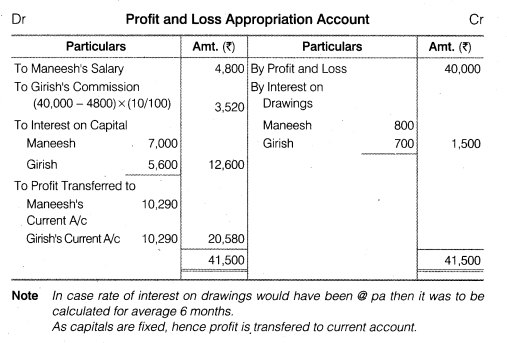
8. Ram, Raj and George are partners sharing profits in the ratio 5 : 3 : 2. According to the partnership agreement George is to get a minimum amount of Rs. 10,000
as his share of profits every year. The net profit for the year 2006 amounted to Rs, 40,000. Prepare the Profit and Loss Appropriation Account.
Answer


9.Amann, Babita and Suresh are partners in a firm. Their profit sharing ratio is 2:2:1. Suresh is guaranteed a minimum amount of Rs. 10,000 as share of profit,
every year. Any deficiency on that account shall be met by Babita. The profits for two years ending December 31, 2005 and December 31, 2006 were Rs. 40,000 and Rs. 60,000, respectively. Prepare the Profit and Loss Appropriation Account for the two years.
Answer


10. Simmi and Sonu are partners in a firm, sharing profits and losses in the ratio of 3:1. The profit and loss account of the firm for the year ending March 31, 2006 shows a net profit of Rs. 1,50,000. Prepare the Profit and Loss Appropriation Account by taking into consideration the following information:
(i) Partners capital on April 1, 2005; Simmi, Rs. 30,000; Sonu, Rs. 60,000;
(ii) Current accounts balances on April 1, 2005; Simmi, Rs. 30,000 (cr.); Sonu, Rs. 15,000 (cr.);
(iii) Partners drawings during the year amounted to Simmi, Rs. 20,000; Sonu, Rs. 15,000;
(iv) Interest on capital was allowed @ 5% p.a.;
(v) Interest on drawing was to be charged @ 6% p.a. at an average of six months;
(vi) Partners’ salaries : Simmi Rs. 12,000 and Sonu Rs. 9,000. Also show the partners’ current accounts.



11.Ramesh and Suresh were partners in a firm sharing profits in the ratio of their capitals contributed on commencement of business which were Rs. 80,000 and Rs. 60,000 respectively. The firm started business on April 1, 2005. According to the partnership agreement, interest on capital and drawings are 12% and 10% p.a., respectively. Ramesh and Suresh are to get a monthly salary of Rs. 2,000 and Rs. 3,000, respectively.
The profits for year ended March 31, 2006 before making above appropriations was Rs. 1,00,300. The drawings of Ramesh and Suresh were Rs. 40,000 and Rs. 50,000, respectively. Interest on drawings amounted to Rs. 2,000 for Ramesh and Rs. 2,500 for Suresh. Prepare Profit and Loss Appropriation Account and partners’ capital accounts, assuming that their capitals are fluctuating.
Answer



12.Sukesh and Vanita were partners in a firm. Their partnership agreement
provides that:
(i) Profits would be shared by Sukesh and Vanita in the ratio of 3:2;
(ii) 5% interest is to be allowed on capital;
(iii) Vanita should be paid a monthly salary of Rs. 600.
The following balances are extracted from the books of the firm, on December 31, 2006.

Net profit for the year, before charging interest on capital and after charging partner’s salary was Rs. 9,500. Prepare the Profit and Loss Appropriation Account and the Partner’s Current Accounts.
Answer

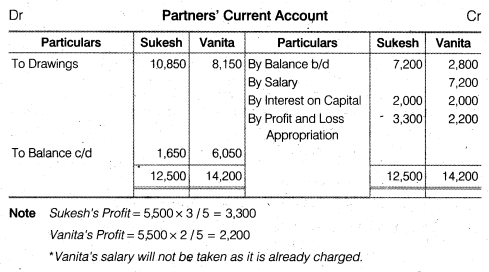
13.Rahul, Rohit and Karan started partnership business on April 1, 2006 with capitals of Rs. 20,00,000, Rs. 18,00,000 and Rs. 16,00,000, respectively.
The profit for the year ended March 2007 amounted to Rs.1,35,000 and the partner’s drawings had been Rahul Rs. 50,000, Rohit Rs. 50,000 and Karan Rs. 40,000. The profits are distributed among partner’s in the ratio of 3:2:1. Calculate the interest on capital @ 5% p.a

14.Sunflower and Pink Rose started partnership business on April 01, 2006 with capitals of Rs. 2,50,000 and Rs.1,50,000, respectively. On October 01, 2006,
they decided that their capitals should be Rs. 2,00,000 each. The necessary adjustments in the capitals are made by introducing or withdrawing cash.
Interest on capital is to be allowed @ 10% p.a. Calculate interest on capital as on March 31, 2007.
Answer

15.On March 31, 2006 after the close of accounts, the capitals of Mountain, Hill and Rock stood in the books of the firm at Rs. 4,00,000,Rs.3,00,000 and Rs. 2,00,000, respectively. Subsequently, it was discovered that the interest on capital @ 10% p.a. had been omitted. The profit for the year amounted to Rs. 1,50,000 and the partner’s drawings had been Mountain: Rs. 20,000, Hill Rs. 15,000 and Rock Rs. 10,000. Calculate interest on capital.
Answer

16.Following is the extract of the Balance Sheet of, Neelkant and Mahdev as on March 31, 2007:

During the year Mahadev’s drawings were Rs. 30,000. Profits during 2007 is Rs. 10,00,000. Calculate interest on capital @ 5% p.a for the year ending March 31, 2007.


17.Rishi is a partner in a firm. He withdrew the following amounts during the year ended March 31, 2007.
May 01, 2006 Rs. 12,000
July 31, 2006 Rs. 6,000
September 30, 2006 Rs. 9,000
November 30, 2006 Rs. 12,000
January 01, 2007 Rs. 8,000
March 31, 2007 Rs. 7,000
Interest on drawings is charged @ 9% p.a. Calculate interest on drawings
Answer

18.The capital accounts of Moli and Golu showed balances of Rs.40,000 and Rs. 20,000 as on April 01, 2006. They shared profits in the ratio of 3:2. They allowed interest on capital @ 10% p.a. and interest on drawings, @ 12 p.a. Golu advanced a loan of Rs. 10,000 to the firm on August 01, 2006.
During the year, Moli withdrew Rs. 1,000 per month at the beginning of every month whereas Golu withdrew Rs. 1,000 per month at the end of every month. Profit for
the year, before the above mentioned adjustments was Rs.20,950. Calculate interest on drawings show distribution of profits and prepare partner’s capital accounts.
Answer




19. Rakesh and Roshan are partners, sharing profits in the ratio of 3:2 with capitals of Rs. 40,000 and Rs. 30,000, respectively. They withdrew from the firm the following amounts, for their personal use:

Interest is to be charged @ 6% p.a. Calculate interest on drawings, assuming that book of accounts are closed on March 31, 2007, every year.


20.Himanshu withdrews Rs. 2,500 at the end Month of each month. The Partnership deed provides for charging the interest on drawings @ 12% p.a. Calculate interest on Himanshu’s drawings for the year ending 31st December, 2006.

21. Bharam is a partner in a firm. He withdraws Rs. 3,000 at the starting of each month for 12 months. The books of the firm closes on March 31 every year. Calculate interest on drawings if the rate of interest is 10% p.a.

22.Raj and Neeraj are partners in a firm. Their capitals as on April 01, 2005 were Rs. 2,50,000 and Rs. 1,50,000, respectively. They share profits equally. On July
01, 2005, they decided that their capitals should be Rs. 1,00,000 each. The necessary adjustment in the capitals were made by introducing or withdrawing
cash by the partners’. Interest on capital is allowed @ 8% p.a. Compute interest on capital for both the partners for the year ending on March 31, 2006


23.Amit and Bhola are partners in a firm. They share profits in the ratio of 3:2. As per their partnership agreement, interest on drawings is to be charged @ 10% p.a. Their drawings during 2006 were Rs. 24,000 and Rs. 16,000, respectively. Calculate interest on drawings based on the assumption that the amounts were withdrawn evenly, throughout the year.

24.Harish is a partner in a firm. He withdrew the following amounts during the
year 2006 : Rs.
February 01 4,000
May 01 10,000
June 30 4,000
October 31 12,000
December 31 4,000
Interest on drawings is to be charged @ 7 1/2 % p.a.
Calculate the amount of interest to be charged on Harish’s drawings for the year ending December 31, 2006.
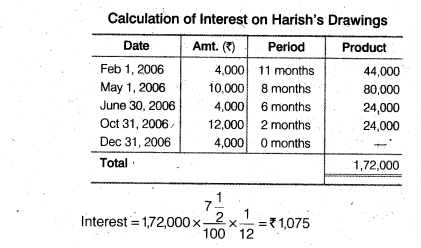
25.Menon and Thomas are partners in a firm. They share profits equally. Their monthly drawings are Rs. 2,000 each. Interest on drawings is to be charged @ 10% p.a. Calculate interest on Menon’s drawings for the year 2006, assuming that money is withdrawn: (i) in the beginning of every month, (ii) in the middle of every month, and (iii) at the end of every month.

26.On March 31, 2003, after the close of books of accounts, the capital accounts of Ram, Shyam and Mohan showed balance of Rs. 24,000 Rs. 18,000 and Rs. 12,000, respectively. It was later discovered that interest on capital @ 5% had been omitted. The profit for the year ended March 31, 2003, amounted to Rs. 36,000 and the partner’s drawings had been Ram, Rs. 3,600; Shyam, Rs. 4,500 and Mohan, Rs. 2,700. The profit sharing ratio of Ram, Shyam and Mohan was 3:2:1. Calculate interest on capital.


27.Amit, Sumit and Samiksha are in partnership sharing profits in the ratio of 3:2:1. Samiksha’ share in profit has been guaranteed by Amit and Sumit to be a minimum sum of Rs. 8,000. Profits for the year ended March 31, 2006 was Rs. 36,000. Divide profit among the partners.
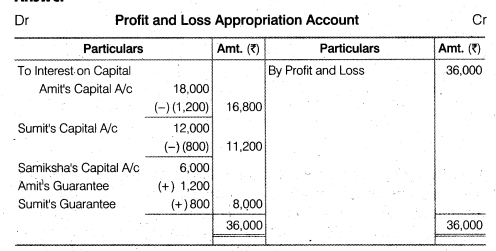

28.Pinki, Deepati and Kaku are partner’s sharing profits in the ratio of 5:4:1. Kaku is given a guarantee that his share of profits in any given year would not be less than Rs. 5,000. Deficiency, if any, would be borne by Pinki and Deepti equally. Profits for the year amounted to Rs. 40,000. Record necessary journal entries in the books of the firm showing the distribution of profit.

29.. Abhay, Siddharth and Kusum are partners in a firm, sharing profits in the ratio of 5:3:2. Kusum is guaranteed a minimum amount of Rs. 10,000 as per share in the profits. Any deficiency arising on that account shall be met by Siddharth. Profits for the years ending March 31, 2006 and 2007 are Rs. 40,000 and 60,000 respectively. Prepare Profit and Loss Appropriation Account.

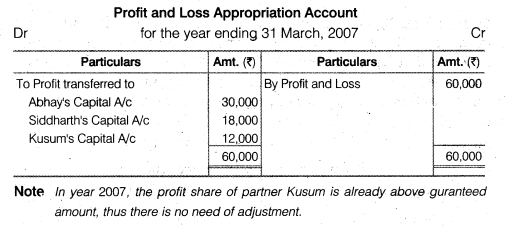
30.Radha, Mary and Fatima are partners sharing profits in the ratio of 5:4:1. Fatima is given a guarantee that her share of profit, in any year will not be less than Rs. 5,000. The profits for the year ending March 31, 2006 amounts to Rs. 35,000. Shortfall if any, in the profits guaranteed to Fatima is to be borne by Radha and Mary in the ratio of 3:2. Record necessary journal entry to show distributioin of profit among partner.
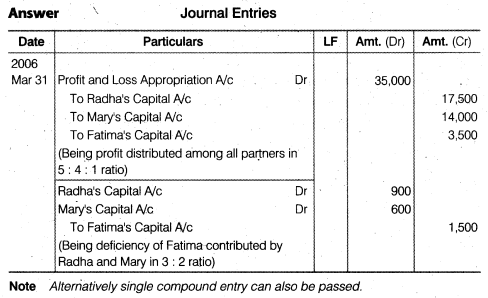
31.X, Y and Z are in Partnership, sharing profits and losses in the ratio of 3 : 2 : 1, respectively. Z’s share in the profit is guaranteed by X and Y to be a minimum of Rs. 8,000. The net profit for the year ended March 31, 2006 was Rs. 30,000. Prepare Profit and Loss Appropriation Account, indicating the amount finally due to each partner.


32.Arun, Boby and Chintu are partners in a firm sharing profit in the ratio or 2:2:1. According to the terms of the partnership agreement, Chintu has to get a minimum of Rs. 60,000, irrespective of the profits of the firm. Any Deficiency to Chintu on Account of such guarantee shall be borne by Arun. Prepare the profit and loss appropriation account showing distribution of profits among partners in case the profits for year 2006 are: (i) Rs. 2,50,000; (ii) 3,60,000.


33.Ashok, Brijesh and Cheena are partners sharing profits and losses in the ratio of 2 : 2 : 1. Ashok and Brijesh have guaranteed that Cheena share in any year shall be less than Rs. 20,000. The net profit for the year ended March 31, 2006 amounted to Rs. 70,000. Prepare Profit and Loss Appropriation Account .


34.Ram, Mohan and Sohan are partners with capitals of Rs. 5,00,000, Rs. 2,50,000
and 2,00,000 respectively. After providing interest on capital @ 10% p.a. the
profits are divisible as follows:
Ram 1/2 , Mohan 1/3 and Sohan 1/6 . But Ram and Mohan have guaranteed that Sohan’s share in the profit shall not be less than Rs. 25,000, in any year.
The net profit for the year ended March 31, 2007 is Rs. 2,00,000, before charging interest on capital. You are required to show distribution of profit


35.Amit, Babita and Sona form a partnership firm, sharing profits in the ratio of 3 : 2 : 1, subject to the following :
(i) Sona’s share in the profits, guaranteed to be not less than Rs. 15,000 in any year.
(ii) Babita gives guarantee to the effect that gross fee earned by her for the firm shall be equal to her average gross fee of the proceeding five years,
when she was carrying on profession alone (which is Rs. 25,000). The net profit for the year ended March 31, 2007 is Rs. 75,000. The gross fee earned by Babita for the firm was Rs. 16,000. You are required to show Profit and Loss Appropriation Account (after giving effect to the alone).
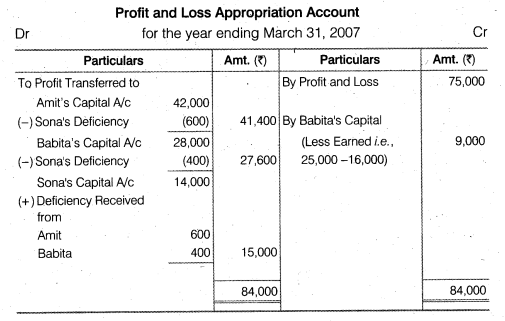

36.The net profit of X, Y and Z for the year ended March 31, 2006 was Rs. 60,000 and the same was distributed among them in their agreed ratio of 3 : 1 : 1. It was subsequently discovered that the under mentioned transactions were not recorded in the books :
(i) Interest on Capital @ 5% p.a.
(ii) Interest on drawings amounting to X Rs. 700, Y Rs. 500 and Z Rs. 300.
(iii) Partner’s Salary : X Rs. 1000, Y Rs. 1500 p.a.
The capital accounts of partners were fixed as : X Rs. 1,00,000, Y Rs. 80,000 and Z Rs. 60,000. Record the adjustment entry.


37. The firm of Harry, Porter and Ali, who have been sharing profits in the ratio of 2 : 2 : 1, have existed for same years. Ali wants that he should get equal share in the profits with Harry and Porter and he further wishes that the change in the profit sharing ratio should come into effect retrospectively were for the last
three year. Harry and Porter have agreement on this account.
The profits for the last three years were:
(Rs.)
2003-04 22,000
2004-05 24,000
2005-06 29,000
Show adjustment of profits by means of a single adjustment journal entry.


38.Mannu and Shristhi are partners in a firm sharing profit in the ratio of 3 : 2. Following is the balance sheet of the firm as on March 31, 2006.

Profit for the year ended March 31, 2006 was Rs. 5,000 which was divided in the agreed ratio, but interest @ 5% p.a. on capital and @ 6% p.a. on drawings was inadvertently enquired. Adjust interest on drawings on an average basis for 6 months. Give the adjustment entry



39.On March 31, 2006 the balance in the capital accounts of Eluin, Monu and Ahmed, after making adjustments for profits, drawing, etc; were Rs. 80,000, Rs. 60,000 and Rs. 40,000 respectively. Subsequently, it was discovered that interest on capital and interest on drawings had been omitted. The partners were entitled to interest on capital @ 5% p.a. The drawings during the year were Eluin Rs. 20,000; Monu, Rs. 15,000 and Ahmed, Rs. 9,000. Interest on drawings chargeable to partners were Eluin Rs, 500, Monu Rs. 360 and Ahmed Rs. 200. The net profit during the year amounted to Rs. 1,20,00



40.Azad and Benny are equal partners. Their capitals are Rs. 40,000 and Rs. 80,000, respectively. After the accounts for the year have been prepared it is discovered that interest at 5% p.a. as provided in the partnership agreement, has not been credited to the capital accounts before distribution of profits. It is decided to make an adjustment entry at the beginning of the next year. Record the necessary journal entry.



41. Kavita and Pradeep are partners, sharing profits in the ratio of 3 : 2. They employed Chandan as their manager, to whom they paid a salary of Rs. 750 p.m. Chandan deposited Rs. 20,000 on which interest is payable @ 9% p.a. At the end of 2001 (after the division of profit), it was decided that Chandan should be treated as partner w.e.f. Jan. 1., 1998 with 1/6 th share in profits. His deposit being considered as capital carrying interest @ 6% p.a. like capital of other partners. Firm’s profits after allowing interest on capital were as follows:
(Rs.)
2001 Profit 59,000
2002 Profit 62,000
2003 Loss (4,000)
2004 Profit 78,000
Record the necessary journal entries to give effect to the above



42.Mohan, Vijay and Anil are partners, the balance on their capital accounts being Rs. 30,000, Rs. 25,000 and Rs. 20,000 respectively. In arriving at these figures, the profits for the year ended March 31, 2007 amounting to Rupees 24,000 had been credited to partners in the proportion in which they shared profits. During the tear their drawings for Mohan, Vijay and Anil were Rs. 5,000, Rs. 4,000 and Rs. 3,000, respectively. Subsequently, the following omissions were noticed:
(a) Interest on Capital, at the rate of 10% p.a., was not charged.
(b) Interest on Drawings: Mohan Rs. 250, Vijay Rs. 200, Anil Rs. 150 was not recorded in the books.
Record necessary corrections through journal entries.

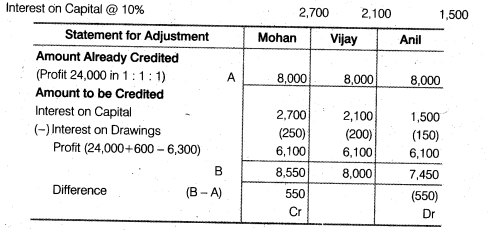

43.Anju, Manju and Mamta are partners whose fixed capitals were Rs. 10,000,
Rs. 8,000 and Rs. 6,000, respectively. As per the partnership agreement, there
is a provision for allowing interest on capitals @ 5% p.a. but entries for the
same have not been made for the last three years. The profit sharing ratio
during there years remained as follows:
Year Anju Manju Mamta
2004 4 3 5
2005 3 2 1
2006 1 1 1
Make necessary and adjustment entry at the beginning of the fourth year i.e. Jan. 2007.



44.Dinker and Ravinder were partners sharing profits and losses in the ratio of 2:1. The following balances were extracted from the books of account, for the year ended December 31, 2005.


Prepare final accounts for the year ended December 31,2005, with following
adjustment:
(a) Stock on December 31,2005, was Rs. 42,500.
(b) A Provision is to be made for bad debts at 5% on debtors.
(c) Rent outstanding was Rs.1,600.
(d) Wages outstanding were Rs.1,200.
(e) Interest on capital to be allowed on capital @ 4% per annum and interest on drawings to be charged @ 6% per annum.
(f) Dinker and Ravinder are entitled to a Salary of Rs.2,000 per annum
(g) Ravinder is entitled to a commission Rs.1,500.
(h) Depreciation is to be charged on Building @ 4%, Plant and Machinery, 6%, and furniture and fixture, 5%.
(i) Outstanding interest on loan amounted to Rs. 350.
Answer


More Resources for CBSE Class 12
RD Sharma class 12 Solutions
NCERT Solutions for Class 12th English Flamingo
NCERT Solutions for Class 12th English Vistas
CBSE Class 12 Accountancy
NCERT Solutions for Class 12th Maths
CBSE Class 12 Biology
CBSE Class 12 Physics
CBSE Class 12 Chemistry
CBSE Sample Papers For Class 12
NCERT SolutionsAccountancyBusiness StudiesMacro EconomicsCommerce